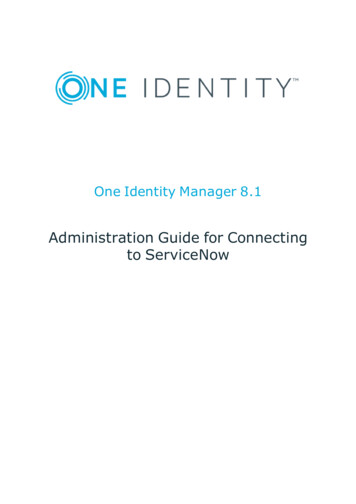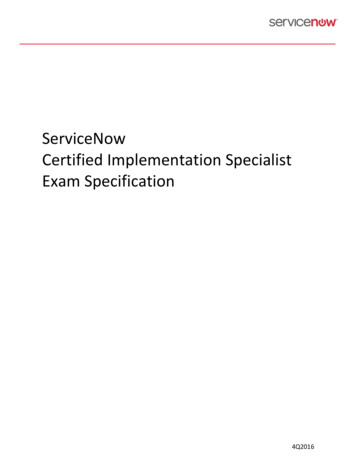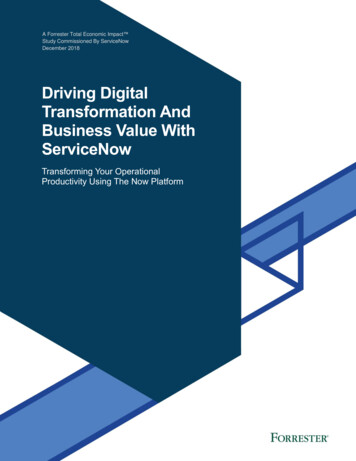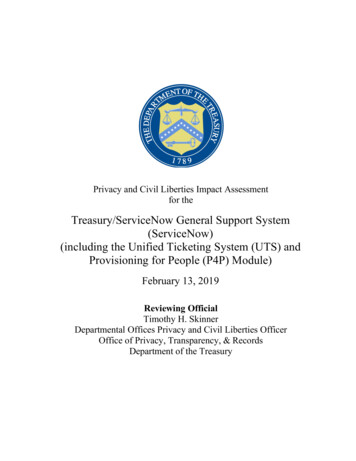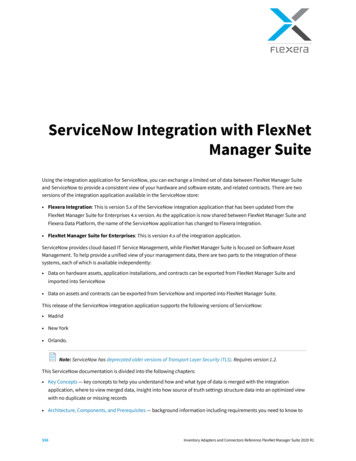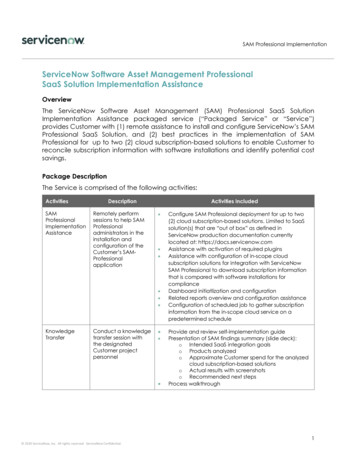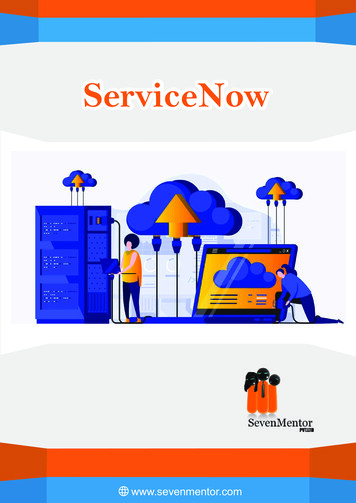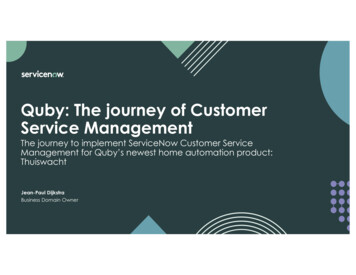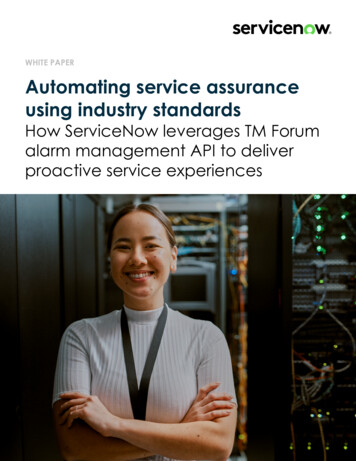
Transcription
WHITE PAPERAutomating service assuranceusing industry standardsHow ServiceNow leverages TM Forumalarm management API to deliverproactive service experiences
WHITE PAPERTable of contentsRising expectations for proactive service experiences3It’s time to redefine service assurance3Five reasons why proactive service experience is difficult to achieve4Four key elements to make automated service assurance a reality5Using TM Forum standards to enable proactive experiences6Automating service assurance with ServiceNow6The better way to automate service assurance8Shifting the paradigm of service operations with ServiceNow9Conclusion92
WHITE PAPERRising expectations for proactive service experiencesDigital experience expectations have drastically evolved over the past few years.It’s now standard practice for ecommerce companies to proactively notify customers if there are serviceissues with orders—such as shipping delays—and how the issues will be resolved. Those same consumer-likeservice experiences are expected of communications service providers (CSPs), and they are undersignificant pressure to deliver or be pushed even further down the value chain.With cost pressures and growing expectations from customers,Communications Service Providers (CSPs) need to continuouslyimprove the quality of service (QoS) on their networks.In this new era of digital experience, CSPs need to proactively identify service issues before or when theyhappen by predicting certain patterns on the network and proactively finding a remediation path usingautomation or machine learning (ML) and artificial intelligence (AI). Keeping humans in the loopthroughout the entire process is key—care and network teams need to understand what’s happening onthe network in order to support resolution, and customers need proactive communication about theimpact and resolution process.This type of proactive service experience helps CSPs make big strides towards improving net promoterscores (NPS) and customer satisfaction scores (CSAT).It’s time to redefine service assuranceIf you look under the hood in any network operations center (NOC), you will likely find an assortment ofnetwork management tools that have been installed for years, if not decades. Before next-gen serviceswere born, these tools worked well for fault and performance management, as well as root cause analysis,within specific domains.In today’s competitive landscape—with new assets entering the mix and with increasingly complexnetworks—this approach no longer works for a myriad of reasons, but primarily because siloed legacysystems cannot deliver end-to-end visibility of all elements across the customer, employee, andpartner ecosystem.With 5G and Software-Defined Networking (SDN) starting to take center stage, there is a need for amore modernized, unified approach to service assurance. One that delivers end-to-end visibility ofthe entire telecom ecosystem, including physical, logical, and virtual layers.Yet CSPs still struggle to bring the old and new worlds of network resources together in order to deliverproactive experiences and automate service assurance.3
WHITE PAPERFive reasons why proactive service experienceis difficult to achieveThe ecosystem of a CSP is massive and will only continue to grow in complexity as networks evolve.ServiceNow has observed five key issues why CSPs struggle to deliver proactive experiences today.1Inability to map resource to customerCSPs struggle to map what is happening on the network to theimpacted customer because they do not have the customer or servicecontext. As a result, the CSP cannot notify the affected customer(s).2Heterogenous networksMultiple different heterogeneous networks are becoming morecommon. The complexity of these networks and topology makesthe resource mapping even more challenging.3Myriad of monitoring toolsHeterogenous networks come with a set of different monitoring toolsthat exist in various network environments, making it difficult for CSPsto correlate and link events together.4Lack of orchestration and workflowDifferent organizations and teams need to work seamlessly to resolvean incident. With so many different network monitoring tools, it becomesincreasingly difficult to enable orchestration across all the different toolsand different organizations to provide a seamless experience.5Growing complex ecosystemThe introduction of 5G and SDN will amplify challenges, especially when itcomes to network slicing. Identifying how service level agreements (SLAs)are impacted, who the impacted customers are, how to notify them,and how to remediate those services and impacted resources all posesignificant challenges as networks evolve.4
WHITE PAPERFour key elements to make automatedservice assurance a realityNetwork teams know all too well that when an event comes in,it causes a flurry of activity to happen across different tools anddifferent domains. Network teams need the ability to providecross-domain correlation, root cause analysis, and de-duplicationto identify the root cause of the particular network event. Theyalso need to determine dependency mapping of the networkand proactively create an incident on the network, identifyingwhich resource needs to be resolved. Only then can they kickoff a workflow to notify impacted customers and begin theremediation process.Want to learn more?Watch the on-demandwebinar:Sounding the alarm forproactive experiencesTM Forum Global Architecture Frameworkwebinar; November 2020In this scenario, achieving automated service assurance meansCSPs need the ability to prioritize cases and rank remediationbased on service level agreements (SLAs) or operational levelagreements (OLAs), which requires four key elements:Map the networkA CSP likely has multiple heterogeneous network platforms, inventory, anddiscovery systems that exist in their environment. ServiceNow serves as theconnective tissue for mapping the entire network; the fundamental corefor enabling proactive notification and resolution paths.Monitor and detectOnce the network is mapped, a CSP can now monitor and detect theissues happening and perform root case analysis for those issues.Provide early warningInformation is then taken and used to proactively notify both internalstakeholders and customers being impacted, creating a notificationvia an incident to ensure the appropriate remediation path.Drive resolutionWith early warnings provided, resolution can now be initiated. Resolutionsshould be recorded and should incorporate AI and ML algorithms runningunderneath the resolution process in order to learn from those resolutionpaths, especially if it's human-driven. Resolution can further be automatedas confidence builds.5
WHITE PAPERUsing TM Forum standards to enable proactive experiencesAchieving automated service assurance starts by standardizing network monitoring data, which is whyTM Forum Open API 642 (TMF642 API) plays such a critical role. ServiceNow leverages TMF642 API for alarmmanagement, which provides a seamless standards-based integration to any network monitoring platformin order to leverage data in a standardized fashion.TM Forumaligned API forinteroperabilitywith any networkmonitoring toolsCI classesspecifically alignedfor supportingtelecom networkOOTB workflowsfor device, port,link, soft-WANfailures, etc.Task orders foreasy auditing fornetwork teamsResource, service,and customermappingIntelligentcase creationIntegration towork ordersImage: TMF642 alarm management for proactive experienceAutomating service assurance with ServiceNowWith ServiceNow, CSPs can leverage and enhance existing network planning and inventory tools byconsolidating all network data into the ServiceNow service-aware configuration management database (CMDB).Think of the ServiceNow CMDB as the service contextualization layer that brings together data fromnetwork planning, inventory, and discovery tools; a relationship model that provides information likeresources used, services running on top of those resources, and the relationship between differentnetwork technologies and domains.6
WHITE PAPERServiceNow also functions in the Service Operations layer, working and integrating with the various toolsin the NOC. The business context and instrumentation across a variety of domain-specific networkmonitoring tools is the key domain where ServiceNow helps increase efficiency in operations for a CSP.ServiceNow Service-Aware CMDBService Operations ManagementNetwork OperationsPublic CloudCoreCore NFWTransportEdge NFWAccessEdge devicesDataAppsAppCustomersiteNetwork monitoring toolsNetwork Operations CenterService Operations Center Fault & event Change management Cross-domain correlation Performance Research, triage,& remediation Dependency mapping Decision supportfor remediation CMDB sync/reconciliation Proactive servicemonitoring Service visualization Trouble ticketmanagement Device & domaincorrelation Field scheduling planning Test and traffic AIOps Change managementImage: ServiceNow serves as the service operations layer for orchestrating service assuranceWith a single-pane view, CSPs can nowincrease productivity while reducingmean time to repair (MTTR). Proactivenotifications can now be delivered to thecustomer via the channel of their choice,improving QoS and reducing SLA andOLA breaches. Further, resolution can beautomated using assurance workflowstied to field technicians for increasedeffectiveness and reduced fulfillment time.Think of ServiceNow as theconnective tissue that bringstogether data from the networkand layers service context on top.Source: IDC, “Digital network operations: Are you ready for what’s coming?”7
WHITE PAPERThe better way to automate service assurance in telecomDesigned using TMF642 API and ServiceNow’s Telecommunications solution, now CSPs can achieve amore efficient process to automate service assurance.15Something happens.Be it a fault or performancedegradation, an event isidentified by yournetworkmonitoringtools.The incident gets associatedto a network team withthe correct priorities andurgencies, along withresources being impacted.TMF64223The event getspushed usingTMF642 API.EventIncident47Based on the definedbusiness processes, theevent is translated intoan alert.The alert referencesServiceNow to correlatenetwork and serviceinformation, and anincident is created.A proactive case is created for eachindividual customer impacted by the service,and the impacted customers are proactivelynotified via their channel of choice.Case6The incident referencesback to ServiceNow,identifying which service(s) customer(s) arecorrelated to the impactednetwork resources.Proactive agentHappy customer8
WHITE PAPERShifting the paradigm of service operationswith ServiceNowReimagining service assurance requires CSPs to think out of the box and take bold steps to invest insolutions that have customers, employees, and partners in mind. There is also a significant need to pivotand change the way we think about service operations, from traditional resolution tasks to a paradigmthat shifts into service operations.This shift requires customer-to-service mapping, alignment to TM Forum standards, and automatedworkflows, all delivered on a single integrated cloud-native platform that breaks down silos and bringscustomer and network data together, finally.ConclusionAt ServiceNow, we believe that behind every great experience, is a great workflow. As CSPs beginto reimagine the customer experience to one that proactively informs customers and resolves issues asthey occur, it’s critical to connect the customer and agents to operations and the network in a simpleand streamlined way. TM Forum’s Open API standards ensures interoperability in the evolving digitalecosystem. As the industry continues to transform, these standards allow CSPs to evolve a componentof their architecture without disrupting the entire ecosystem.Proactive experience is just the tip of the iceberg when it comes to leveraging TM Forum APIs. Adheringto standards and having a consistent mechanism to integrate is a key pillar for digital transformation.ServiceNow is a proud member of TM Forum.Award-winning 2020 catalyst project: Outstanding Use of TM Forum AssetsInform blog: Enabling the ecosystem: The new role of the vendor 2022 ServiceNow, Inc. All rights reserved. ServiceNow, the ServiceNow logo, Now, Now Platform, and other ServiceNow marks are trademarks and/orregistered trademarks of ServiceNow, Inc. in the United States and/or other countries. Other company names, product names, and logos may betrademarks of the respective companies with which they are associated. cenow.com9
Automating service assurance with ServiceNow With ServiceNow, CSPs can leverage and enhance existing network planning and inventory tools by consolidating all network data into the ServiceNow service-aware configuration management data base (CMDB). Think of the ServiceNow CMDB as the service contextualization layer that brings together data from
